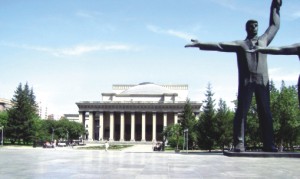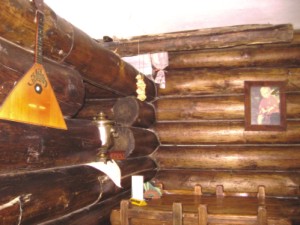|
Travel
From Red Square to Tiananmen Square
A Trans-Siberian Tale
Hamid Rashid
Part 2 continued
Siberia At Last!
 We woke up late the next morning. The sun was glorious and we opened the shades to devour the Russian countryside. The never-ending lines of birches and oaks soaked our eyes with a kind of green that we don't see in Bangladesh. Our green is lush and lustrous it can almost cast a spell on you. The Russian green seemed distant and gloomy, as if waiting in fear of winter when it must surrender to an overwhelming, overpowering white grasp. While watching and comparing the two types of greens, we eagerly waited for the line that divides Europe from Asia. All of a sudden, the continental boundary became an important issue for us. It's a bit strange that we care about the line when we are on the ground. But we hardly worry about such divides when we fly across continents. We woke up late the next morning. The sun was glorious and we opened the shades to devour the Russian countryside. The never-ending lines of birches and oaks soaked our eyes with a kind of green that we don't see in Bangladesh. Our green is lush and lustrous it can almost cast a spell on you. The Russian green seemed distant and gloomy, as if waiting in fear of winter when it must surrender to an overwhelming, overpowering white grasp. While watching and comparing the two types of greens, we eagerly waited for the line that divides Europe from Asia. All of a sudden, the continental boundary became an important issue for us. It's a bit strange that we care about the line when we are on the ground. But we hardly worry about such divides when we fly across continents.
The line never came or we never got to see it. It was supposed to be 40 km before Yekaterinburg one of the last large cities in European Russia. Siberia officially begins there 2102 km east of Moscow. Yekaterinburg kept us waiting for long and we did not reach it until evening. The city has a long history. But it is most famous for being the place where the last Russian Czar Nicholas II and his family were executed. It is also famous as the birth place of Boris Yeltsin, who returned capitalism to Russia that it had lost in 1917. Yekaterinburg represented the full circle of history. Our train stopped for just about 20 minutes so did not have a chance to go to the city.
The journey began again in the glowing afternoon. I felt a mixture of envy and misfortune to see the vast emptiness of the Russian east. Often for hours, we would not see a soul from our window on the train. I tried to imagine how many people we would see during the five hour train ride from Dhaka to Chittagong. The contrast depressed me. In Bangladesh, people fight over an inch of land, they go to court and wait for years to get justice over a petty land dispute. Corrupt politicians collude to deprive a city of its parks and grab land without any sign of guilt. And here in Russia land is plentiful, apparently fertile and habitable. Yet, we hardly see a taker, a tiller, a toiling farmer in the vast Russian countryside. The country-side looked deserted. I could not help feeling sad in the vast inequities in the distribution of land worldwide. Tolstoy would have felt the same way I am sure he would have understood the
pains of Bangladeshi farmers.
We hold the notion of state as sacrosanct and national boundaries as inviolable. Morality takes a backseat in the name of national interest. Tolstoy's famous story, “How much Land a Man Needs” perhaps needs to be re-phrased “How Much Land a Country Needs” to feel secure and powerful. Empires are long gone but our desire to hold on to past gains and historical accidents are omnipresent. I am not just talking about Russia. There are many countries that have so much land and so few people. Take the example of Mongolia 2.8 million in 1.56 million sq. kilometers. Or, look at Kazakhstan or Madagascar. Some would argue that many of these places are not fit for human habitation. I would beg to differ. Given a chance, Bangladeshi farmers will be able to grow something even on the dark side of the moon.
We spent the second night on the train in anticipation of our arrival in Novosibirsk the unofficial capital of Siberia. We crossed a few other Russian cities Tyumen and Toblosk - at night. The next morning we reached Omsk, the former capital of Siberia. Omsk is 2716 km from Moscow. The city earned his fame or notoriety as the place where dissidents were exiled during the Czarist time. Fyodor Dostoevsky was exiled in this city in 1849. His famous piece, Buried Alive in Siberia, recounts his horrific imprisonment in Omsk.
 |
A Typical Siberian Restaurant |
The temperature in Omsk was over 30 degrees Celsius. Before we left Moscow, a good friend of ours had written from the U.S. asking whether it would be freezing cold in Siberia. He is an MIT trained environmental economist and yet not totally free from the stereotypes associated with Siberia. Siberia is thought of as an ever-cold, frosted, desolate far away land. Very few reckon that most of the Siberian towns are located at the same latitude as Toronto, Buffalo or Seattle. Before coming Moscow, I spent about two weeks in Geneva and Brussels. Weather in those two cities was much chillier than what we experienced, both in Moscow and in Siberia. Many find it hard to believe that Siberia too has its share of hot summer days. We learned that during the months of July and August, the temperature often crosses the 40 degree Celsius mark. Mid-thirties is the average summer temperature, with plenty of sun. One of the souvenirs my wife took back with her was a Siberian sunburn.
Novosibirsk was our first real tryst with Siberia. It is a splendid, modern city the third largest in the Russian Federation. A German friend in Dhaka convinced us that we must have a stopover in Novosibirsk. He lived there a few years before coming to Dhaka. We were really happy that we listened to our friend and spent a night in Novosibirsk. The city grabbed us by the arm. Its train station was more grand - an architectural marvel - than any of the stations we saw en route.
Novosibirsk is also the most “white” city that I have visited in my life and my list includes many cities in the Southern United States, Northern Canada, Germany and Scandinavia. I never felt so self-conscious about being a non-white. There were many curious eyes on the street. But the people came across as friendly and warm more so than the Muscovites.
Novosibirsk is a quintessential Trans Siberian city. The city rests on the bank of mighty Ob river and was established in 1893, just when the construction of the railway began. It was created to serve as the hub of Siberia a city that connected the two continents. Because the city is relatively new, it is lined with wide boulevard, promenades and squares. Its architecture is eye-catching. The biggest attraction of Novosibirsk is its silver-domed Opera House the largest in all of Russia. It can reportedly seat 1500 people. Akademigorod, a soviet-type suburb that housed major scientific research during the cold war, is nearby. Akademigorod was off limit to foreigners until the collapse of the Soviet Union.
In Novosibirsk, we enjoyed a truly authentic Siberian meal at Zhili Byli. The food was great but the service was not. Twice we ordered a dish from the menu and twice the waiter came back from the kitchen to tell us that they ran out of it. Later we learned that it was usual for Russian restaurants not to have the dishes listed on their menu. There was also a mistake in our bill, which we explained with quite difficulty. But the restaurant is a must go for the visitors because of its Siberian décor. The oak covered walls and cabin-like atmosphere, with Siberian outfit worn by the wait-staff made up for the service shortfalls.
We had to change our ticket at Novosibirsk to leave for Irkutsk a day early. Luckily, while waiting on a line at the station, we met a team of Methodist Missionaries who were accompanied by a young Russian Mikhail - who spoke impeccable English. Even his accent was perfect. It would have been hard to say he was not a native English speaker if we did not know that he was actually a Russian who never left his homeland. I asked Mikhail where he learned English. He was frank to admit that picked up his English from watching Mel Gibson's movies. We were truly impressed. He was also kind enough to help us change our ticket. During our conversation, he told us that he was from Yekaterinburg. Our bond became stronger when he found that we knew where it was.
We also met Natasha at Lenina park, who made an earnest effort to have a conversation with us. She came from the city of Bernaul in the Altai region. When we told her that we knew her town, she was very pleasantly surprised. On the same day, we met a travel agent who was also from the same town. It was an interesting coincidence. Novosibirsk seemed very wealthy, with a very large young population. The city attracted many aspiring artists, sopranos and ballerinas that gave the city its vibrancy. We were sad to leave Novosibirk our train for Irkutsk left the memorable station at 10:00 pm local time.
To be continued
Copyright (R) thedailystar.net 2007 |
